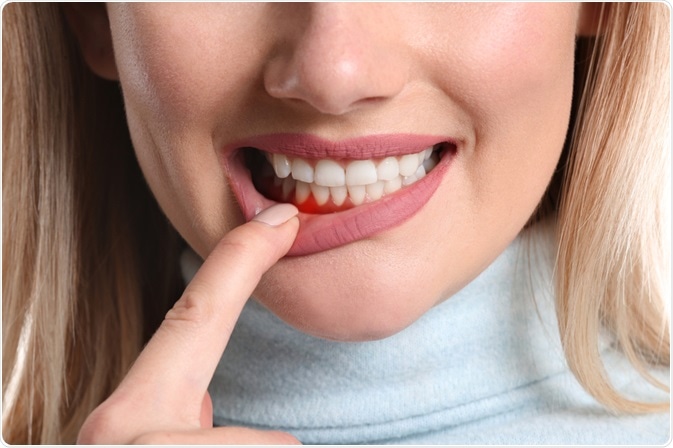Gingivitis is a mild and common form of gum disease that causes the gums to become inflamed, red and irritated.
 Image Credit: Pixel-Shot/Shutterstock.com
Image Credit: Pixel-Shot/Shutterstock.com
As gingivitis is often mild, people may be unaware that they have it, but it is important to take the condition seriously and ensure that prompt treatment is received before it leads to a more severe form of gum disease called periodontitis. According to the American Dental Association, gingivitis and periodontitis are leading causes of tooth loss in adults.
Healthy gums are pale, pink and firm, whereas gums affected by gingivitis become swollen, tender, darkish red and tend to bleed easily. Most gum swelling occurs as the result of bacterial plaque, a film of debris that accumulates along the gum line and teeth surfaces and begins to build up underneath the gum pocket if it is not regularly removed.
This plaque infection of the gums triggers an immune response which causes the gum tissue to become inflamed. If left unchecked, gingivitis can eventually cause the gums to detach from the teeth, exposing the soft tissue and supportive bone to injury. The teeth can then become loose and if the infection progresses, it will ultimately lead to tooth loss.
Most individuals experience some degree of gum disease at some point in their life and approximately 50% of adults have gum disease to some extent.
Symptoms of gingivitis include the following:
- Gums that have pulled away from the teeth
- Malocclusion (a change in how the teeth fit together when biting)
- Loose teeth
- Sensitive teeth
- Bad breath that is no longer resolved by teeth cleaning
- Pain on chewing
- Pus between the teeth and gums
Gingivitis is usually caused by poor oral hygiene and by maintaining good oral health through regular teeth cleaning, daily flossing and attending dental checkups, gingivitis can be prevented.
Diagnosis of gingivitis
During a dental examination, the dentist usually carries out a number of procedures to check for gingivitis and periodontitis. Gingivitis can be diagnosed early on in routine dental examinations and involves the following:
- The teeth and gums are examined in detail for evidence of the early stages of tooth decay and plaque. The dentist checks the shape and color of gingival tissue on the buccal (cheek) side and lingual (tongue) side of each tooth. Swollen, painful, red or peeling gums and the presence of any ulcers or abscesses is noted, as is the amount of plaque and tartar present. The dentist will also check how sensitive the teeth are, whether there is any teeth movement and whether the teeth are correctly aligned. The movement of the teeth is tested by pushing each tooth between two handles and looking for any movement. Tooth mobility is a strong indicator that bone loss has occurred.
- A detailed account of the patient’s medical history is taken to check for any past or present gum disease or underlying conditions that could contribute to the development of periodontitis. The dentist also asks about oral hygiene routines, any medications the patient is taking, dietary habits and lifestyle habits such as drinking and smoking.
- One of the most helpful ways to detect tooth decay and damage is by carrying out a dental X-ray. An X-ray may help detect small lesions of tooth decay that have not yet caused cavities. Jaw X-rays may help determine the severity of gum involvement and whether any bone loss has occurred.
- Periodontal probing may also be used to test for periodontitis. The probe is a long, thin stick that is inserted beside the tooth under the gum line, with the tip placed in the gum pocket. The tip then touches the point where the tooth is attached to connective tissue. The probe is then “walked” to six particular points on each tooth, three on the buccal side and three on the lingual side and the depth that the probe reaches is measured at each point. When gums are healthy, their attachment to the tooth is firm and the probe cannot slide very far below the gum line. This probing enables the dentist to establish the condition of the connective tissue and how much gingival recession or overgrowth has occurred. A normal depth for the probe to slide is 1 to 3 mm. Deeper sliding of the probe may indicate periodontitis.
- One of the complications of gingivitis is trench mouth, which describes the formation of infective ulcers on the gums. A swab may be used to take a sample of discharge from the ulcers, which can then be examined under a microscope to identify the causal bacteria. An appropriate antibiotic can then be selected for treating the condition.
Gingivitis and periodontitis - causes, symptoms, diagnosis, treatment, pathology
Treatment of gingivitis
To treat gingivitis, people must maintain good oral hygiene. There are several techniques that can be used to deep clean the teeth and these include scaling, where tartar is removed from below and above the gum line; root planing, which smoothes any rough areas and removes infected parts of the tooth and laser treatment, which is a less painful way of removing tartar than root planing or scaling.
Several medications are also available to help treat the condition including time-release antiseptic chips which are inserted into gum pockets after root planing; antibiotic microspheres, which are inserted after either scaling or root planing and oral antibiotics, which are used to treat persistent inflammation. An antibiotic mouthwash that contains chlorhexidine can also be used to clear the mouth of infection.
Severe gum disease may require surgery. Flap surgery may be performed, where the gums are folded back so that plaque can be removed. The gums are then fixed back in place snugly around the tooth. Tissue or bone grafts may be carried out to treat cases where the teeth and jaw are beyond healing.
Further reading
Further Reading
Last Updated: Aug 22, 2023